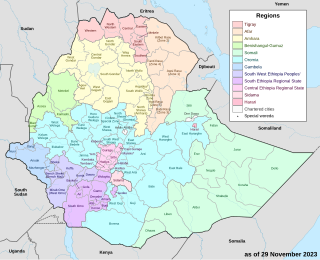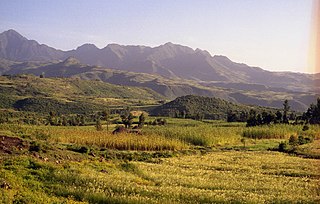History
The Swedish Red Cross report encountering a customs post at Shakiso when moving at the southern front in early 1936. There were two substantial waterholes there, although the water was somewhat salty. The customs staff had four small buildings on the top of a hill near the main road. Their primary task was to collect salt tax from caravans, which amounted to ten or eleven Maria Theresa Thalers per month before the Second Italian-Abyssinian War. [3]
Following the savage suppression of their revolt in 1960, numerous members of the Gedeo people were forcibly evicted from their homes, and over the following years some migrated to Shakiso to settle. However, the unrest of the early years of the Ethiopian Revolution forced many of these migrants to leave Shakiso for their homeland. [4]
Tahir Shah describes Shakiso in his 2002 book, In Search of King Solomon's Mines, as "a frontier town" which isn't mentioned in travel books "nor was it on my map." The main street featured shops "selling Western contraband—Walkmans and televisions, Swiss Army knives, Russian vodka, lacy underwear, Marlboro cigarettes and CDs." These goods were offered to miners with ample disposable income from working both the official gold mine at Lega Dembi, as well as countless illegal gold mines in the Adola greenstone belt. [5]
Land clashes in June 2006 between the rival Guji and Borena Oromo clans left about 100 people dead in and around the towns of Shakiso, Arero and Yabelo. According to Oxfam, more than 20,000 people had fled from the environs of Shakiso. [6]
By March, 2009, drinkable water projects with a budget of 38 million Birr were underway at Shakiso and Adola Wayou, which were expected to benefit 72,000 residents. [7]

Oromia is a regional state in Ethiopia and the homeland of the Oromo people. Under Article 49 of Ethiopian Constitution, the capital of Oromia is Addis Ababa, also called Finfinne. The provision of the article maintains special interest of Oromia by utilizing social services and natural resources of Addis Ababa.
Yabelo is a town in southern Ethiopia. An alternative name for this town is Obda, which is also the name of a nearby mountain. Located northwest of Moyale in the Borena Zone of the Oromia, this town has a latitude and longitude of 4°53′N38°5′E and an elevation of 1857 meters above sea level. It has been the administrative center of the Borena Zone since its division from Guji Zone in September 2002, as well as Yabelo woreda.

Dembidollo, also spelled Dembi Dolo, is a market town and separate woreda in south-western Ethiopia. It is the capital of Kelam Welega Zone of the Oromia Region. This town, which is at an elevation of between 1,701 m (5,581 ft) and 1,827 m (5,994 ft) above sea level, was originally known as Sayo.

Borena is a zone in Oromia Region of Ethiopia. Borena is named after one of the two major subgroups of the Oromo People. Borena is bordered on the south by Kenya, on the west by the Southern Nations, Nationalities, and Peoples Region, on the north by West Guji and Guji and on the east by Dawa Zone Somali Region. The highest point in this zone is Mount Dara Tiniro. Cities and major towns in this Zone include Negele Borana, Moyale, Yabelo, Dubuluk, Mega, Millami, Surupa and Bakke.
Wenago is one of the woredas in the Southern Nations, Nationalities, and Peoples' Region of Ethiopia. Part of the Gedeo Zone, Wenago is bordered on the southwest by Yirgachefe, on the northwest by the Oromia Region, on the northeast by Dila Zuria, and on the southeast by Bule. Towns in Wenago include Wenago. Dila Zuria woreda and Dila town were separated from Wenago.
The Guji Oromo are an Oromo clan living Guji Zone in southern Oromia of Ethiopia. They are distinguished by their agro-pastoral lifestyle. According to a population projection from 2007, the total population of the Guji Oromo is above 5 million. The Guji have lived in their territory for many centuries. They claim that their cradle land is Girja.

Sululta is a town and woreda in Oromia Region, Ethiopia. It was part of former Mulona Sululta woreda which was separated for Mulo and Sululta woredas. Part of the Oromia Special Zone Surrounding Finfinne, Sululta is bordered to the south by the city of Addis Ababa, to the west by the Mulo and West Shewa Zone, to the north by North Shewa Zone, and to the east by Bereh. Towns in Sululta include Chancho, Durba, Muger Sheleko, Rob Gebeya, Sululta and Segno Gebeya.
Uraga is one of the Aanaas in the Oromia of Ethiopia. Part of the Guji Zone, Uraga is bordered on the south by Odo Shakiso, on the west by the Borena Zone, on the north by the Southern Nations, Nationalities, and Peoples Region, and on the east by Bore. The largest town in Uraga is Haro Wachu. Dama and Hambela Wamena woredas were separated from Uraga.
Bore is one of the Aanaas in the Oromia of Ethiopia. Part of the Guji Zone, Bore is bordered on the south by Ana Sora, on the west by the Uraga, and on the north and east by the Southern Nations, Nationalities, and Peoples Region. The largest town in Bore is Bore.
Adola is one of the woredas in the Oromia Region of Ethiopia. It is part of former Adolana Wadera woreda what was divided for Adola, Girja and Wadera woredas and Adola town. Part of the Guji Zone, Adolana Wadera was bordered on the south by Liben, on the southwest by Odo Shakiso, on the west by Bore, on the north by the Southern Nations, Nationalities, and Peoples Region, and on the east by the Bale Zone.
Odo Shakiso is one of the Aanaas in the Oromia of Ethiopia. Part of the Guji Zone, Odo Shakiso is bordered on the south by the Dawa River which separates it from Arero, on the west by Bule Hora, on the northeast by Uraga, on the north by Bore, on the northeast by Adolana Wadera, and on the east by Liben. Towns in Odo Shakiso include Shakiso and Megado.
Bule Hora is a woreda in Oromia Region, Ethiopia. It formerly included Dugda Dawa and Kercha districts. Part of the West Guji Zone, Bule Hora was bordered on the south by the Dawa River which separates it from Arero, on the southwest by Yabelo, on the west by the Southern Nations, Nationalities, and Peoples Region and Gelana Abaya, on the northeast by Uraga, and on the east by Odo Shakiso. The largest town of Bule Hora is Bule Hora Town.
Arero is a woreda in Oromia Region, Ethiopia. Part of the Borena Zone, Arero is bordered on the southwest by Dire, on the west by Yabelo, on the north by Bule Hora, on the northeast by the Guji Zone, on the east by the Somali Region, and on the south by Moyale; the Dawa River, the only river in this woreda, separates Arero from Odo Shakiso and Liben. Towns in Arero include Meta Gefersa.
Abaya is a woreda in the Oromia Region, Ethiopia. It is part of former Gelana Abaya woreda what was divided for Abaya and Gelana woredas. Part of the Borena Zone, Gelana Abaya was bordered on the south by Hagere Mariam, and on the west, north and east by the Southern Nations, Nationalities, and Peoples Region (SNNPR). Lake Abaya, on the western border, is divided between this woreda and the SNNPR. However, the Guji Oromo who live in Nechisar National Park are claimed to be administratively part of this woreda, in a kebele called "Irgansaa".
Adola is a town located in the Guji Zone of the Oromia Region, at an altitude of 1,758 metres (5,768 ft) above sea level. 470 km from Addis Ababa.

Guji is a zone in Oromia Region of Ethiopia. Guji is named after a tribe of the Oromo people. Guji is bordered on the south by Borena, on the west by the Southern Nations, Nationalities, and Peoples Region, on the north by the Ganale Dorya River which separates it from Bale and on the east by the Somali Region. The highest point in this zone is Mount Dara Tiniro. Cities and major towns in this Zone include its administrative center, Nagele, Shakiso Bore, Dila Adola.
The Gedeo are an ethnic group in southern Ethiopia. The Gedeo Zone in the Southern Nations, Nationalities, and People's Region (SNNPR) is named for this people. They speak the Gedeo language, which is one of the Cushitic languages.
Mohammed International Development Research and Organization Companies (MIDROC) is a mining and oil company owned by Ethiopian billionaire Sheik Mohammed Hussein Al Amoudi. It has operations in Europe, the Middle East, and Africa. Through its Corral Petroleum Holdings AB, MIDROC has become a major independent oil company.
The Gedeo–Guji clashes were a territorial conflict between the Guji Oromo and the Gedeo people, that began in 1995. The clashes led to about 800,000 mostly ethnic Gedeos fleeing their homes, a higher number and over a shorter period of time, than occurred at the height of the more publicized Rohingya crisis in Myanmar the year before. The government pressured the refugees to return to their homes even though they fear for their lives, often by denying refugees access to humanitarian aid.

The Lega Dembi Mine is the largest gold mine in Ethiopia and is near Shakiso in Oromia. Lega Dembi has a yearly production of around 4,500 kg of gold and silver, and is owned by MIDROC. Pollution from the mine has resulted in environmental conflict that has exacerbated other political and ethnic conflict in the region.





